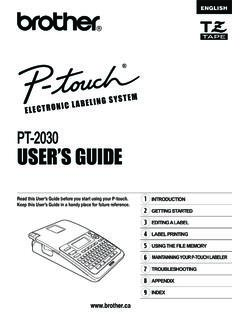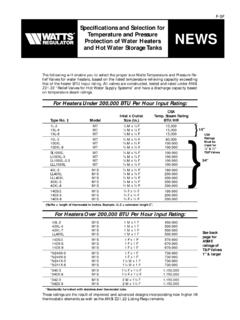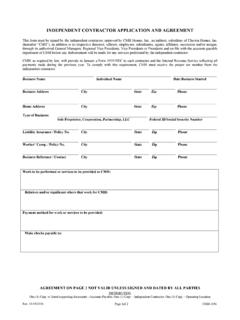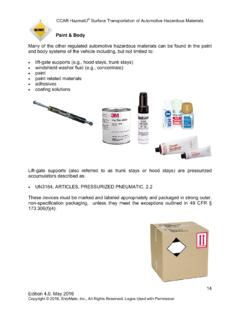Transcription of Review Superparamagnetic Iron Oxide Nanoparticles as …
1 Theranostics 2013, Vol. 3, Issue 8 595. Ivyspring International Publisher Theranostics 2013; 3(8):595-615. doi: Review Superparamagnetic iron Oxide Nanoparticles as MRI. contrast agents for Non-invasive Stem Cell Labeling and Tracking Li Li, Wen Jiang, Kui Luo, Hongmei Song, Fang Lan, Yao Wu and Zhongwei Gu . National Engineering Research Center for Biomaterials, Sichuan University, 29 Wangjiang Road, Chengdu 610064, Sichuan, China. Corresponding author: Zhongwei Gu, National Engineering Research Center for Biomaterials, Sichuan University, No. 29, Wangjiang Road, Chengdu, Sichuan, 610064, Tel.: +86-28-85410336 Fax: +86-28-85410653 E-mail: Yao Wu, National Engi- neering Research Center for Biomaterials, Sichuan University, No. 29, Wangjiang Road, Chengdu, Sichuan, 610064, Tel.
2 : +86-28-85460576 Fax: +86-28-85410653 E-mail: Ivyspring International Publisher. This is an open-access article distributed under the terms of the Creative Commons License ( licenses/by-nc- ). Reproduction is permitted for personal, noncommercial use, provided that the article is in whole, unmodified, and properly cited. Received: ; Accepted: ; Published: Abstract Stem cells hold great promise for the treatment of multiple human diseases and disorders. Tracking and monitoring of stem cells in vivo after transplantation can supply important information for determining the efficacy of stem cell therapy. Magnetic resonance imaging (MRI) combined with contrast agents is believed to be the most effective and safest non-invasive technique for stem cell tracking in living bodies.
3 Commercial Superparamagnetic iron Oxide Nanoparticles (SPIONs) in the aid of transfection agents (TAs) have been applied to labeling stem cells. However, owing to the potential toxicity of TAs, more attentions have been paid to develop novel SPIONs with specific surface coating or functional moieties which facilitate effective cell internalization in the absence of TAs. This Review aims to summarize the recent progress in the design and preparation of SPIONs as cellular MRI probes, to discuss their applications and current problems facing in stem cell la- beling and tracking, and to offer perspectives and solutions for the future development of SPIONs in this field. Key words: stem cells, Superparamagnetic iron Oxide Nanoparticles , labeling, tracking, magnetic resonance imaging.
4 Namics in vivo. Currently, several imaging method- Introduction ologies have been applied for this purpose, including Stem cells are biological cells found in all multi- positron emission tomography (PET) [9-11], single cellular organisms, which possess the capability of photon emission computed tomography (SPECT) [12], self-renewal and differentiation into various cell lin- bioluminescence imaging (BLI) [13, 14], fluorescence eages. Until now, stem cells have been applied to not imaging [15-21], X-ray based computed tomography only cell-based therapies, for example, the treatment (CT) [22] and magnetic resonance imaging (MRI) [5, of ischaemic [1], degenerative [2], immune [3] and 23-27]. Among them, MRI shows advantages over the genetic diseases [4], but also regenerative medicine, others owing to its high spatial resolution ( 100 m), such as the repair or regeneration of damaged heart long effective imaging window, rapid in vivo acquisi- [5], cartilage [6, 7] and bone tissue [8].
5 Accordingly, tion of images, and the absence of exposure to ioniz- the tracking and monitoring of these stem cells after ing radiation [28-31]. It has shown promising future in delivery into human body is very important for a tracing cells in vivo. However, the sensitivity of MRI is comprehensive understanding of their proliferation generally lower as compared to SPECT and biolumi- dynamics, differentiation process and migration dy- nescence. Thus, the development of MRI contrast Theranostics 2013, Vol. 3, Issue 8 596. agents with high efficiency and sensitivity becomes times of water protons. T2 agents provide dark nega- essential to allowing successful bio-imaging at the tive signal intensity in images and can be used to cellular and molecular level.
6 Visualize stem cells grafted in organs that appear as The MRI contrast agents in clinic are divided into high signal intensity ( kidney or lymphoid tissues). two parts, including T1 and T2 agents. Some of them in Compared to T1 agents, Superparamagnetic iron Oxide the commercial market are shown in Table 1. T1 NPs (SPIONs) based T2 agents appear to be the pre- agents, such as paramagnetic metal lanthanide, can ferred MRI contrast agents for monitoring stem cells alter the longitudinal (T1) relaxation times of water due to their high sensitivity and excellent biocom- protons to produce bright positive signal intensity in patibility [40]. By far, the common labeling approach images and increase the conspicuousness of cells. Ini- for stem cell labeling and imaging is based on com- tially, chelate complexes of gadolinium (Gd3+), such as bining commercially available SPIONs ( Feridex.)
7 The clinical contrast agent gadolinium diethy- and Revosit ) with a commercially available transfec- lene-trianmine pentaacetic acid (Gd-DTPA) with the tion agent (TA) ( Superfect , poly(L-lysine)(PLL). aid of transfection agents (TAs), were employed to [41-43], Lipofectamine [44, 45], or protamine sulfate label stem cells [32-34]. Recently, Gd3+ containing par- [43, 46-48]). However, one of the crucial problems of ticles and macromolecules have been developed as a this approach is the potential toxicity of TAs to living new generation of T1 contrast agents [31, 35-39]. bodies [47]. For example, PLL can cause significant Gd3+-hexanedione NPs (GdH-NPs) produced stronger cell death at the concentration of 10 g/mL in media signal intensity than Gd-DTPA, probably because the [49].
8 Feridex PLL complexes have been reported to larger Gd complexes with high molecular weight in inhibit the chondrogenic differentiation capacity of GdH-NPs caused the slow tumbling rate of GdH-NPs MSCs [50]. In addition, Feridex and Resovist are no [35]. Gd3+-ion clusters within ultra-short single-walled longer available commercially since 2009 [29]. There- carbon nanotubes (Gd3+n @US-tubes) exhibited a T1 fore, extensive efforts have been devoted to the de- relaxivity (r1) 40-fold greater than that of Gd-DTPA. It velopment of novel SPIONs (some of them are shown shortened relaxation time of water in labeled pig in Table 2) in the last decade, leading to a rapid pro- mesenchymal stem cells (pMSCs) two-fold as com- gress in the field of stem cell labeling.
9 The present pared to unlabeled MSCs [36]. The Gd-DTPA bearing Review summarizes the recent information involving poly(ethyleneimine) (SiO2/Gd-DTPA-PEI) [31] and the design consideration and preparation of SPIONs, Gd3+ conjugated peptide dendrimers [37-39] provide discusses the current status of their applications in great possibilities to efficiently label and monitor stem sensitive stem cell labeling and detection, and points cell with high cell uptake efficiency and increased T1 out the current problems and perspectives on future relaxivity. directions in this field. T2 agent is to alter the transverse (T2) relaxation Table 1. Some commercial MRI contrast agents [51, 52]. Brand name Structure Hydrodynam- Classifica- Target Company Ref. ic size (nm) tion Magnevist Gd-DTPA T1 agent Extracellular Bayer Schering (Germany) [32].
10 Omniscan Gd-DTPA-BMA T1 agent Extracellular GE-Healthcare ( ) and Ny- [35, comed (Norway) 40]. Eovist Gd-EOB-DTPA, Gadoxetate T1 agent Extracellular Bayer Schering (Germany) [51]. Ferumoxides Dextran-coated SPIOs 80-150 nm T2 agent Reticuloendo- Advanced Magnetics ( ) [46, (Feridex IV , En- thelial system , 53-5. dorem ) Liver 5]. Stem cell label- ing Resovist Carboxydextran-coated USPI- 20 nm T2 agent Blood pool Bayer Schering (Germany) [45, Osa Stem cell label- 54]. ing Sinerem Dextran-coated USPIOs 15-30 nm T2 agent Blood pool Guerbet (France) [56]. (AMI-227). Ferumoxytol Carboxylmethyl-dextran 30 nm T2 agent Macrophage Advanced Magnetics ( ) [57]. coated USPIOs Blood pool Ferumoxsil Silicon-coated SPIOs 300 nm T2 agent Liver Guerbet, Advanced [58].









